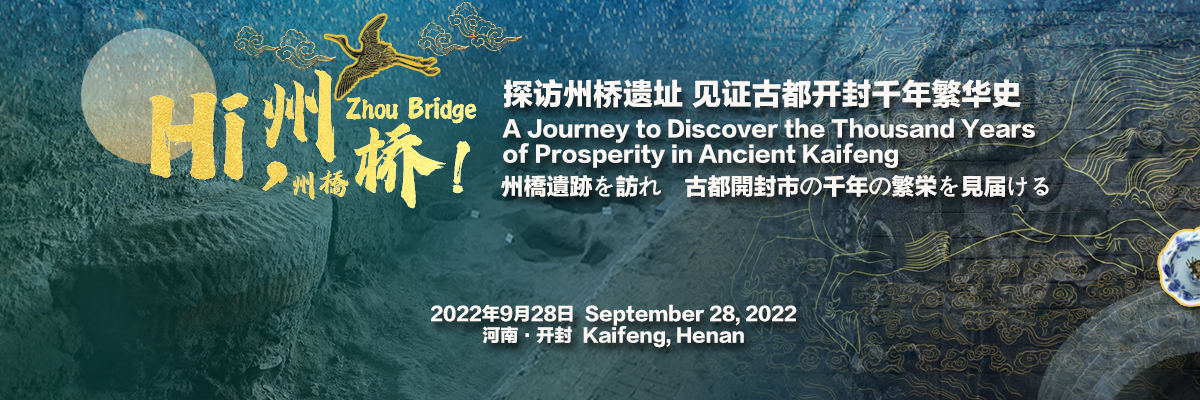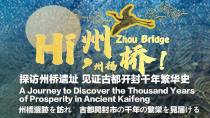-
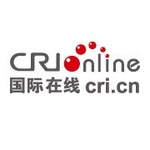 国际在线2022-09-28 12:43
国际在线2022-09-28 12:43本场直播到此结束,感谢大家的观看。
That concludes the livestreaming today. Thank you for watching.
今回の紹介は以上となります。ご視聴ありがとうございました。
-
 国际在线2022-09-28 12:40
国际在线2022-09-28 12:40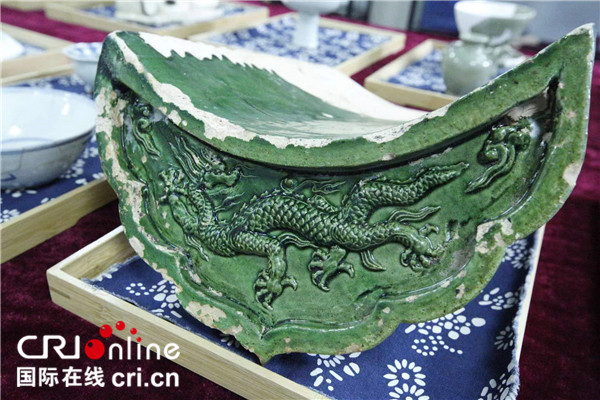
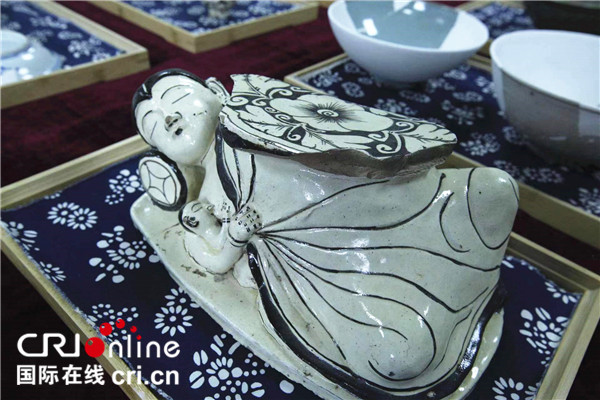
出土文物
The excavated cultural artifacts
出土品
-
 国际在线2022-09-28 12:27
国际在线2022-09-28 12:27
州桥遗址的保护与展示,为更好实施黄河流域生态保护和高质量发展、大运河文化带国家战略,讲好黄河文化、大运河文化故事,推动文旅融合发展,自觉融入“行走河南,读懂中国”,提供了重要文化支撑,为建设国家文化公园、大运河文化公园提供了现实条件。
The protection and exhibition of the Ruins of Zhou Bridge provide invaluable support for better ecological preservation and high-quality development of the Yellow River Basin, the establishment of the Grand Canal Culture Belt as a national strategy, telling good stories of the Yellow River culture and the Grand Canal culture, promoting the integration of culture and tourism, and assisting people in comprehending Chinese culture through their trips to Henan. Moreover, these actions have also contributed to the development of a national cultural park and a national Grand Canal cultural park.
州橋遺跡の保護と展示は、黄河流域の生態保護と質の高い発展、大運河文化ベルト国家戦略をよりよく実施し、黄河文化、大運河文化の物語を語り、文化・観光の融合型発展を推進し、積極的に「河南を歩む、中国を知る」を融合するのに重要な文化的サポートを提供しており、国家文化公園、大運河文化公園の建設に有利な条件を提供しています。
-
 国际在线2022-09-28 12:19
国际在线2022-09-28 12:19据中国社会科学院学部委员、郑州大学特聘教授刘庆柱介绍,州桥和汴河遗址的发掘对研究宋代历史有很重要的作用,发掘成果印证了北宋东京城的布局形制,再次明确开封城市中轴线千年未变。发掘出来的瑞兽、鹤禽、祥云等浮雕图案,雕饰华丽,生动自然,反映的是当时的意识形态和精神标识,代表着繁荣、吉祥和对自然的理解等,这些图案在当时皇家的一些贵重器物上经常可以看到,体现了当时的皇家文化甚至是国家文化。
According to Liu Qingzhu, a member of the Chinese Academy of Social Sciences and a distinguished professor at Zhengzhou University, the Ruins of Zhou Bridge and the Bian River Site are crucial for understanding the history of the Song Dynasty, since they have evidenced the layout of Dongjing in the Northern Song Dynasty, and once more demonstrated that the central axis of Kaifeng has remained unchanged for thousands of years. The excavated relief patterns such as beasts, cranes and birds, and clouds are beautifully carved, vivid and natural, mirroring the ideology and traits of the Chinese spirit of that period and representing prosperity, auspiciousness and understanding of nature. These designs can be frequently found on some of the valuable goods produced at that time, reflecting both the royal and even the national cultures back then.
中国社会科学院学部委員、鄭州大学特別教授の劉慶柱氏によると、州橋と汴河遺跡の発掘は、宋の歴史を研究することに対して重要な意味を持つことがわかりました。発掘成果により、北宋東京城の配置が明らかになり、開封市の中軸線が何千年も変わらないことを改めて証明しました。発掘された華やかで、生き生きとしていた瑞獣、鶴鳥、祥雲などの浮彫図案は、当時のイデオロギーと精神的標識を反映し、繁栄と吉祥、そして自然に対する理解をあらわにしました。当時王家の貴重な器物に、これらの図案をしばしば見られ、王家の文化、ひいては国家の文化がそこに垣間見られます。
-
 国际在线2022-09-28 12:16
国际在线2022-09-28 12:16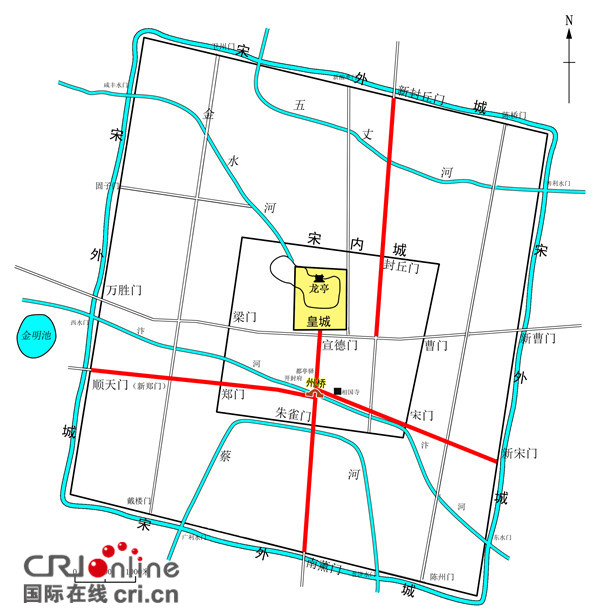
北宋时期的州桥是一处繁华的商业中心,见证了中国古代都城由里坊制转变为街巷制的历史发展过程。州桥遗址的考古发掘成果为研究北宋东京城布局提供了重要坐标,印证了开封城市中轴线(御街)千年未变的事实,反映了中华城市文明演进的历史进程,展现了中国古代城市文明和漕运文化的辉煌成就。
The surrounding area of Zhou Bridge was a bustling business center in the Northern Song Dynasty and witnessed the change of urban layout in the ancient capital city of China. It was transformed from the "Lifang System", where urban areas are symmetrical and residential and business areas are separated, to the "Jiexiang System", where shops can be set up along streets. The archaeological findings of the Ruins of Zhou Bridge offer important proof to the research of the layout of Dongjing in the Northern Song Dynasty and prove the fact that the Imperial Street (Yu Jie), known as the central axis of Kaifeng, has been remaining unchanged for thousands of years. Meanwhile, they reflect the historical development and the evolution of the Chinese urban civilization, and show the remarkable achievements of ancient urban civilization and the culture of canal transportation in China.
北宋時代の州橋は繁栄するビジネスセンターであり、中国古代の都市が里坊制から街巷制へと変化する歴史の変遷・発展を見守りました。州橋遺跡の考古学成果は北宋東京城の配置の研究に重要な座標資料を提供しており、開封市の中軸線(御街)が千年経っても変わらないという事実を証明し、中華都市文明の進化のあゆみを反映し、中国古代都市の文明・漕運文化の輝かしい成果を展示しています。
-
 国际在线2022-09-28 12:11
国际在线2022-09-28 12:11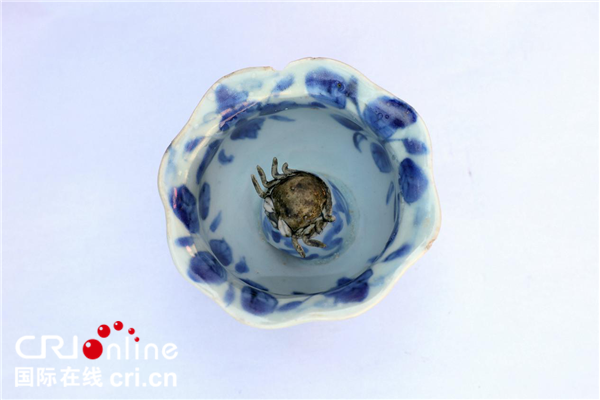
州桥遗址出土的大量文物,记录了古都开封的历史发展脉络。瓷器是中国古代劳动人民的伟大创造,是中国历史文化重要标识之一。州桥遗址出土文物种类丰富,尤以瓷器数量最大,出土了56000多件瓷器标本,涵盖了宋代及以后的众多窑口。瓷器的种类和数量既反映了运河航运辐射的范围,也反映了开封城市不同历史时期经济发展水平。大量瓷器标本出土为研究中国制瓷业的发展史提供了重要实物资料,瓷器上内容丰富的文字、纹饰是研究中国古代绘画、宗教、建筑、科举、市井生活的重要材料。
A great number of cultural artifacts excavated at the Ruins of Zhou Bridge reflect the historical development of ancient Kaifeng, the capital of China during the Northern Song Dynasty. Porcelain is a great creation of ancient Chinese people and is also regarded as one of the crucial symbols of Chinese history and culture. A rich variety of cultural relics were unearthed at the Ruins of Zhou Bridge, with the majority being porcelain objects. There are more than 56,000 porcelain objects found here, covering works from different porcelain kilns in the Song Dynasty and the following dynasties. The variety and quantity of porcelain objects reflect the area that the Grand Canal could cover in ancient times. Moreover, it tells the economic development situation of ancient Kaifeng in different historical periods. It should be noted that the porcelain objects can serve as crucial historical materials for the research of the Chinese porcelain industry. The content including words and patterns on the porcelain objects is also important for the study of paintings, religions, architecture, imperial examinations and daily life of China in the past.
州橋から出土した大量の文化財は、古都開封市の歴史発展の筋道を記録しました。磁器は中国古代の労働者による偉大な創造物であり、中国歴史文化における重要な代表でもあります。州橋遺跡から出土した文化財は種類が豊富で、特に磁器の量が多く、56000点以上の磁器標本が出土し、宋時代以降の多くの窯をカバーしています。磁器の種類と量は、運河での輸送活動範囲を反映し、異なる時期における開封市の経済発展レベルも反映しています。大量の磁器標本が出土したことにより、中国の磁器製造業の発展歴史の研究に重要な実物資料を提供しました。磁器にある豊富な文字、模様が中国古代の絵画、宗教、建築、科挙、日常生活を研究するための重要な資料です。
-
 国际在线2022-09-28 11:55
国际在线2022-09-28 11:55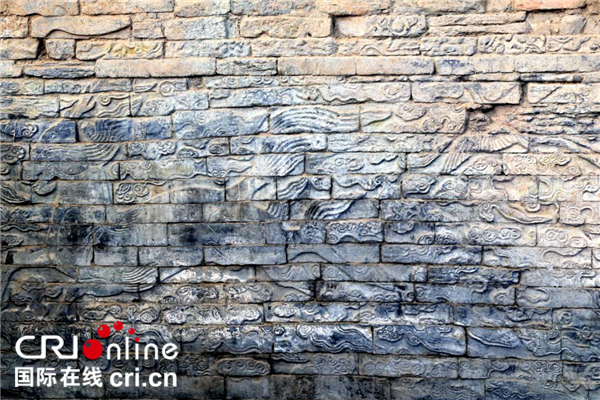
其中,瑞兽、祥云等雕刻生动自然,栩栩如生,与宋代文献记载高度吻合,再现了北宋东京宏大繁荣历史场景。石刻对称分布在桥体两侧,按已经出土石刻面积计算,推测总雕刻面积近约400平方米。州桥以其特殊的地理位置、庞大的规模、精美的石雕,展现了北宋石刻艺术的最高水平,填补了北宋艺术史的空白。
Those auspicious patterns of animals, clouds and other things together present a lively image and are consistent with the historical records in the Northern Song Dynasty. They are good examples to demonstrate the grand and flourishing past of Dongjing in the Northern Song Dynasty. These carvings are symmetrically carved on both sides of the bridge. It is calculated that, based on the total area of the stone carvings unearthed, they nearly cover an area of 400 square meters. Zhou Bridge, with its special location, large size and exquisite carvings, shows the excellence of stone carving art and fills the gap in art history in the Northern Song Dynasty.
そこに、瑞獣、祥雲などの浮彫が生き生きとしていて、宋時代の文献に記載された内容とほぼ一致し、北宋東京の繁栄な歴史シーンを再現しています。石刻は橋本体の両側にあり、出土した石刻の面積から推算すると、総彫刻面積が約400m2があります。州橋はその特殊な地理的位置、巨大な規模、美しい石刻で北宋の石彫刻芸術の最高水準を展示し、北宋の芸術歴史の空白を埋めました。
-
 国际在线2022-09-28 11:51
国际在线2022-09-28 11:51北宋时期的州桥建在汴河与御街的交汇点上,近桥两岸皆石壁,雕镌水兽、飞云之状,规模宏大,雕饰华丽。
Zhou Bridge was built at the intersection of the Bian River and the Imperial Street (Yu Jie) of Dongjing during the Northern Song Dynasty. At that time, there were two spectacular and gorgeous stone walls stretching on both sides of the bridge, adorned with the reliefs of water beasts and auspicious clouds.
北宋の時代の州橋は汴河と御街の交差点に位置し、橋の近くの両岸には石壁があり、そこに彫刻された水獣、雲はたくさんあり、華麗なる装飾が施されています。
-
 国际在线2022-09-28 11:46
国际在线2022-09-28 11:46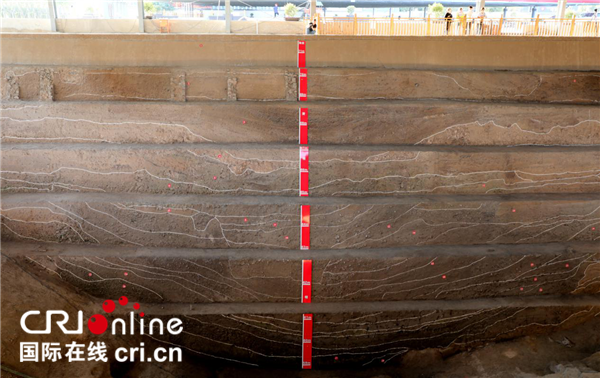
州桥与汴河遗址保存完整,肌理清晰,内容丰富,见证了大运河及东京城的繁荣。州桥遗址中的桥摞桥、路摞路,是开封形成立体叠压型城市“城摞城”奇观的真实再现,揭示了黄河与开封古城共生共存的关系。
The Ruins of Zhou Bridge and the Bian River Site are well preserved with abundant details, reflecting the prosperity of the Grand Canal and Dongjing. By observing the structure and the pavement of the bridge, we may find the characteristics of different periods. These discoveries make up an existing part of the stereoscopic and complicated layout of ancient Kaifeng, revealing the interconnection between the Yellow River and this centuries-old city.
州橋と汴河の遺跡は完全な状態で残され、その筋目がはっきりしていて、内容も豊富で、大運河と東京城の繁栄を見守っています。州橋遺跡の橋摞橋(橋に重ねた橋)、路摞路(道路に重ねた道路)は、開封で立体重なり型都市「城摞城(城に重ねた城)」という奇観を形成する具現化であり、黄河と開封古城の共存関係を示しています。
-
 国际在线2022-09-28 11:43
国际在线2022-09-28 11:43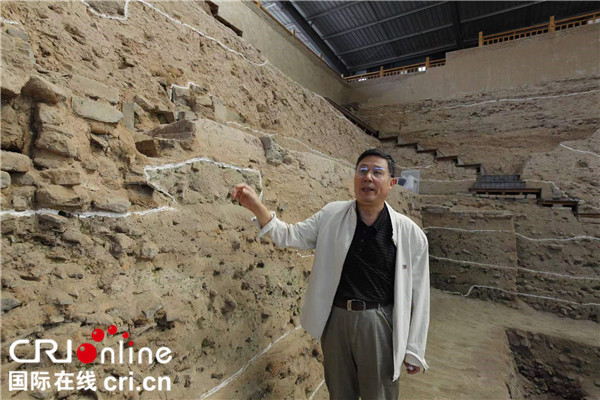
据河南大学特聘教授李合群介绍,汴河是中国古代大运河的重要一段,它成就并见证了北宋东京城的兴盛与繁华。作为北宋东京城的“生命线”,汴河又是沟通当时南北物资、文化交流的一个“黄金水道”。当时通过汴河的漕运定额每年有600万石,一石约为120斤,按每人消费2斤计算,可养活100万人。但是,汴河在金代断流,后又历经数百年黄河泥沙的淤积,汴河故道其迹难觅。现在汴河故道被解剖清理出了一段,展示出了汴河的宽度、深度、河岸设施、文物堆积、历史变迁等。汴河和州桥遗址考古发掘、展示,具有很高的历史、文物与旅游价值,是向世人展示开封历史变迁、城市繁荣、汴河兴衰、大运河文化的一个重要窗口,需要我们研究好、保护好、利用好。
According to Li Hequn, a distinguished professor at Henan University, the Bian River made up a large part of the Grand Canal in ancient China, contributing to and witnessing Dongjing's prosperity in the Northern Song Dynasty (960–1127). The Bian River served as Dongjing's lifeline and a vital conduit for trade and cultural exchanges between the north and the south at that time. At the time, the Bian River's capacity for canal transit was six million dan (about 360 million kilograms) each year, enough to feed one million people at a cost of one kilogram per person. The Bian River, however, stopped flowing during the Jin Dynasty (1115–1234). For many centuries, it has been impossible to locate any remnants of its previous course due to the Yellow River's sedimentation. Recently, part of the old road along the Bian River was cleared, revealing the river's width, depth, amenities on the banks, a number of cultural artifacts, and historical changes. The archaeological findings at the Bian River Site and the Ruins of Zhou Bridge are of great historical and cultural significance, and are expected to become tourist resources favored by the public. They serve as crucial windows into the historical changes of Kaifeng, the prosperity of the city, the rise and fall of the Bian River and the culture of the Grand Canal.
河南大学の李合群名誉教授によると、中国古代の大運河の重要な一段とした汴河は、北宋東京城の隆盛と繁華とつながっています。汴河は、北宋東京城の「生命線」だけでなく、当時の南北間の物資・文化交流をつなぐ「黄金水路」でもあります。そのころ、汴河の輸送クォータは年間600万石でした。一石は約120斤で、一人あたり2斤の消費で計算すると、100万人を養うことができます。しかし、金の時代に、汴河はすでに断流しました。その後数百年にわたって黄河の泥や砂の堆積など原因により、昔の汴河の姿を見つけることはできません。現在、昔の川筋が発見され、汴河の幅と深さ、沿岸の施設、出土した遺物、歴史の変遷などが明らかになっています。汴河と州橋遺跡の考古学的発掘と展示は、歴史的、文化的、観光的価値が高いので、世界に開封の歴史的変遷と都市の繁栄、汴河の盛衰、大運河文化を示す一方、研究と保護、利用を適切にする必要があります。
-
 国际在线2022-09-28 11:34
国际在线2022-09-28 11:34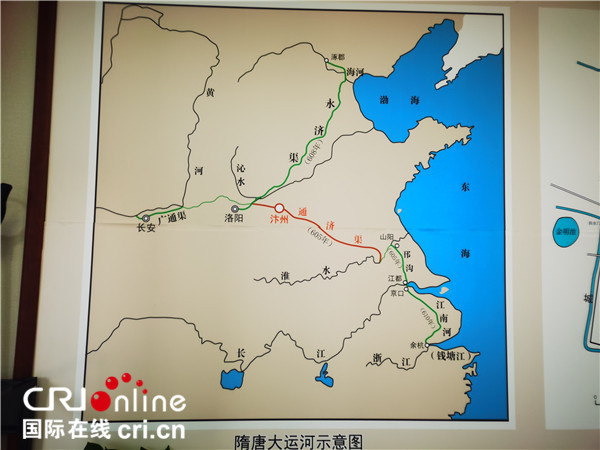
州桥是大运河(汴河)文化遗产的重要代表。北宋时期,汴河托起了北宋东京的盛世繁华,其连通黄河、淮河两大水系,流经荥阳、中牟、开封、商丘等地,由淮河通往江南,年漕运量最高达800万石。
Zhou Bridge is an important and typical cultural heritage site among all the relics at the Bian River section of the Grand Canal. Dongjing became a city of opulence thanks to the Bian River during the Northern Song Dynasty. The River connected the Yellow River and the Huai River and flowed through various places such as Xiangyang, Zhongmu, Kaifeng and Shangqiu. Through the Bian River, people could travel to Jiangnan region. The maximum annual water transport volume at that time could reach eight million dan (473.6 million kilograms).
州橋は大運河(汴河)の文化遺産の重要な代表です。北宋の時代、北宋東京は汴河を頼りに盛んに発展していました。汴河は黄河、淮水の二つの水系をつなぎ、ケイ陽、中牟、開封、商丘などの地域を経由し、淮水から江南へ流れていき、年間漕運(水路での食糧の輸送)量は最大800万石(1石は約29.95kg)がありました。
-
 国际在线2022-09-28 11:30
国际在线2022-09-28 11:30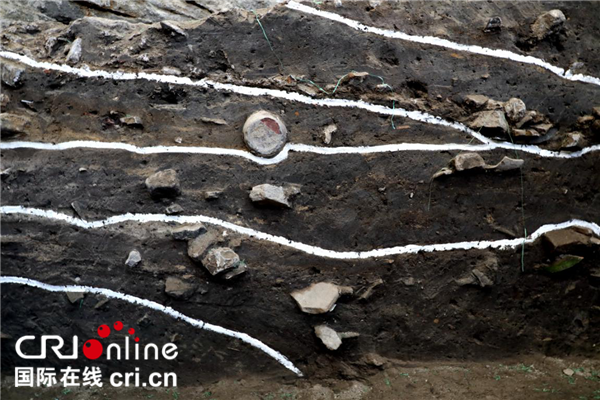
骨器除了工具,还有大量人骨遗骸及各类动物骨骼。人骨遗骸多散落在明代末期洪水淤积层下,应为明末洪水毁城导致;动物骨骼主要发现于河道堆积层中,应为人们食物残留。在州桥东侧金龙四大王庙基址旁发现三尊贴金铜造像,高80厘米—100厘米,极为珍贵。
In addition to bone tools, there are a variety of human remains and bones of animals. Human remains are mainly found under the alluvial layer formed by floods in the late Ming Dynasty. The majority of animal bones were unearthed in the fluvial deposits and they seem to be food waste. Three gilded bronze statues were found beside the base site of Jinlong Sidawang Temple located on the east side of Zhou Bridge, with their heights ranging from 80 to 100 centimeters.
骨器は道具以外に、大量の人骨の遺骸及び異なる動物の骨も出土しました。人骨の遺骸は主に明時代末期の洪積層から発見され、洪水で潰された城の中の死者だと考えられています。動物の骨は主に河道の堆積層から発見され、昔の人の食事で残したものだと考えられています。州橋東側の金龍四大王廟遺跡の近くに金箔を貼った三つの銅像が発見され、80cmから100cmの高さがあり、これはとても貴重な文化財です。
-
 国际在线2022-09-28 11:28
国际在线2022-09-28 11:28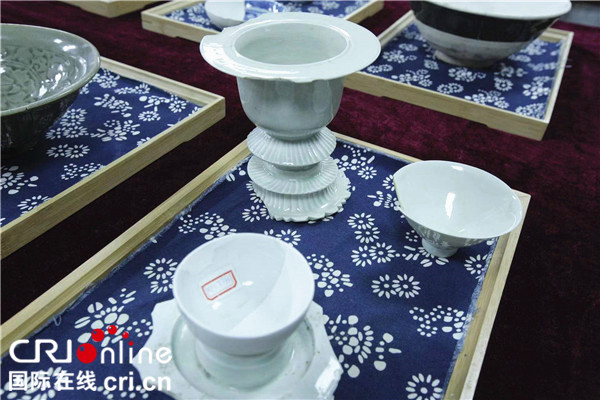
遗址共出土各类文物标本60000多件,质地包括陶、瓷、石、玉、木、骨、金、银、铜、铁、蚌、琉璃等。其中,瓷器标本56000多件,陶器标本1800多件,铜钱1000多枚,骨器200多件,铜器100多件,玉器50多件,石器50多件,铁器30多件。瓷器标本中明代青花瓷数量最大,金元时期白地黑花次之,其它种类有宋金时期白瓷、青白瓷、印花青瓷,金元明时期龙泉青瓷、钧瓷,明清时期的青花、五彩、粉彩等。器形以生活用具为多,包括碗、盘、杯、盏、罐、壶、瓶、盆以及文房用品、玩具。
More than 60,000 cultural artifacts and other relics have been unearthed, including pottery, porcelain, stone, jade, wood, bone, gold, silver, copper, iron, clam and glaze objects. Among all the cultural relics, more than 56,000 porcelain objects, 1,800 pottery objects, 1,000 copper coins, 200 bone tools, 100 bronzeware objects, 50 jade objects, 50 stone tools and over 30 ironware objects have been excavated. In terms of porcelain objects, the blue-and-white porcelain objects made in the Ming Dynasty occupy the first place in terms of number, while the white-glazed porcelain objects with black decorative patterns made in the Jin and Yuan dynasties come second. Other discoveries include white porcelain objects, bluish white porcelain objects, and greenish porcelain objects with carved patterns made in the Song and Jin dynasties, Longquan celadons and Jun ware objects made in the Jin and Yuan dynasties, and blue-and-white porcelain objects, five-colored porcelain objects and porcelain objects with overglaze decoration made in the Ming and Qing dynasties. Most of the porcelain objects are appliances used in daily life, including bowls, trays, cups, small cups, jars, kettles, bottles, pots and stationery items and toys.
遺跡から各種類の文化財標本は計60000点以上が出土し、陶、磁、石、玉、木、骨、金、銀、銅、鉄、貝殻、瑠璃などの素材種類が含まれています。うち、磁器の標本は56000点以上、陶器の標本は1800点以上、銅銭は1000枚以上、骨器は200点以上、銅器は100点以上、玉器は50点以上、石器は50点以上、鉄器は30点以上が出土しました。磁器標本の中、明時代の青花磁器は一番数が多く、金・元の時代の白地黒花磁器の数が続いています。その他には宋・金の時代の白磁、青白磁、印花青磁、金・元・明の時代の龍泉青磁、鈞磁、明・清の時代の青花、五彩、粉彩などもあります。出土した器は生活用品が主として、碗、皿、杯、盞、罐、壺、瓶、鉢及び文房具、玩具があります。
-
 国际在线2022-09-28 11:14
国际在线2022-09-28 11:14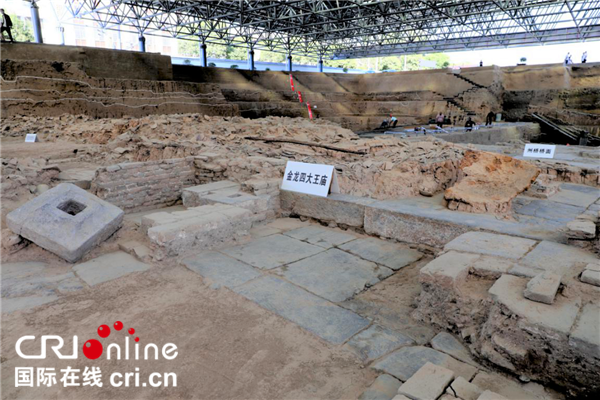
其中,东侧探方中大运河(汴河)故道遗存河道、堤岸特征明显,地层边界清晰;西侧探方中明代州桥结构基本完整,青石铺筑桥面,;桥东侧石壁上雕镌有瑞兽、祥云等浮雕壁画,通高约3.3米,揭露的石壁最长约30米,构成巨幅长卷。另外,在明代州桥桥面与河道中还发现明代晚期金龙四大王庙遗存,也是大运河重要的文化遗产。
The east excavation site shows clear outlines of a canal and banks of the Bian River section of the Grand Canal. At the west excavation site, Zhou Bridge's structure built in the Ming Dynasty is well preserved and we can see the flagstone-paved surface. A stone wall, situated on the east side of Zhou Bridge is engraved with reliefs such as auspicious animals and clouds. The stone wall is about 3.3 meters high and 30 meters long, which is big and spectacular. Besides, relics of Jinlong Sidawang Temple (Jinlong Fourth King's Temple), a temple built in the late Ming Dynasty are found on the surface of Zhou Bridge and in the river course. The remains of this temple constitute a vital part of the cultural heritage of the Grand Canal.
そのうち、東側グリッドにある大運河(汴河)旧河道に残した河道、堤防の特徴が明らかで、地層の境界がはっきりしています。西側グリッドにある明時代の州橋は構造がほぼ完全に残され、橋面が石灰岩を使用して建てられました。橋の東側の石壁は約3.3mの高さで、瑞獣、祥雲などの浮彫壁画が描かれています。掲げた石壁は最長30mがあり、巨大な巻物を形成しています。そのほか、明時代の州橋の橋面と河道に発見された明時代末期の金龍四大王廟の遺跡も大運河の重要な文化遺産です。
-
 国际在线2022-09-28 11:11
国际在线2022-09-28 11:11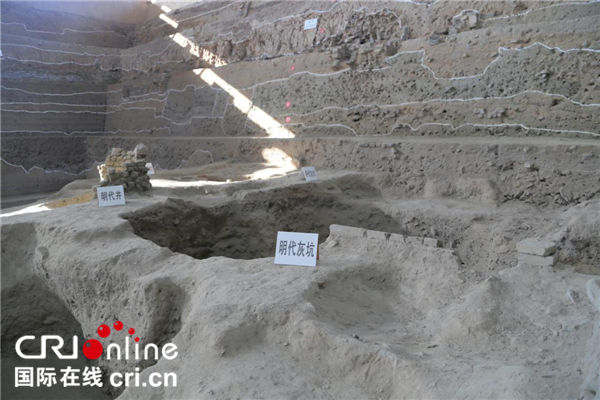
9月28日,国家文物局集中发布北宋东京城州桥遗址相关情况。截至2022年9月,州桥遗址共完成考古发掘面积4400平方米,发现不同时期各类遗存117处,种类包括河道、水工设施、桥梁、道路、神庙、房址、沉船、水井、仓储、灶台、灰坑等。
On September 28, the National Cultural Heritage Administration released reports on the excavation of the Ruins of Zhou Bridge of Dongjing of the Northern Song Dynasty. By the end of September 2022, the area of the Ruins excavated reached 4,400 square meters, covering 117 sites of different periods. So far, river courses, hydraulic facilities, bridges, roads, temples, houses, shipwrecks, wells, warehouses, cooking stoves and dump pits have been unearthed.
9月28日、国家文物局は北宋東京城州橋遺跡の関連情報をまとめて発表しました。2022年9月現在、州橋遺跡の完了した発掘調査面積は計4400m2であり、河道、水事施設、橋、道路、神殿、住宅遺跡、沈没船、井戸、保管倉庫、暖炉、灰坑などの種類を含む各時期の遺跡は117カ所を発見しました。
-
 国际在线2022-09-28 11:04
国际在线2022-09-28 11:04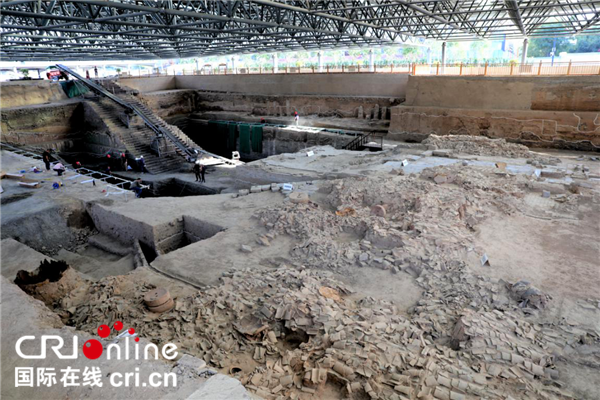
北宋东京城州桥遗址位于今河南省开封市,是北宋东京城御街与大运河汴河段交叉点上的标志性建筑。州桥始建于唐朝,曾历经唐、宋、金、明等朝代的修缮和改建,具有十分丰富的历史文化内涵。为推进大运河重要文物系统性保护整治工程,大力实施宋都古城保护战略,自2018年10月起,河南省文物考古研究院联合开封市文物考古研究所对州桥遗址开展了持续性的考古发掘工作。
The Ruins of Zhou Bridge of Dongjing of the Northern Song Dynasty, now located in Kaifeng, Henan Province, is a landmark at the intersection of the Imperial Street (Yu Jie) of Dongjing and the Bian River section of the Grand Canal. First built in the Tang Dynasty and repaired and reconstructed in the Tang, Song, Jin and Ming dynasties, Zhou Bridge is renowned for its long history and cultural significance. To promote the systematic protection and management of important cultural relics along the Grand Canal and take measures to protect the ancient capital city of the Song Dynasty, Henan Provincial Institute of Cultural Heritage and Archaeology and Kaifeng Institute of Archaeology have worked together to carry out continuous archaeological excavations at the Ruins of Zhou Bridge since October 2018.
北宋東京城州橋遺跡は現在の河南省開封市に位置し、北宋東京城御街と大運河汴河区間の交差点にある代表的な建築です。州橋は唐の時代から建設され、唐、宋、金、明などの時代の補修・リフォームを経て、豊富な歴史文化の内在的な価値を持っています。2018年10月より、大運河の重要文化財の系統的保護・管理プロジェクトを推進し、宋都古城保護戦略の実施を強化するために、河南省文物考古研究院は開封市文物考古研究所と連携して州橋遺跡の考古・発掘調査を続けています。
1
1
直播简介
9月28日,国家文物局发布重大考古发现——北宋东京城州桥遗址。上午11时-12时30分,国际在线将通过《直观中国》栏目,实地探访州桥遗址,聚焦州桥遗址考古成果的历史文化和建筑艺术价值,再现开封城市历史风貌演变过程,展现中华历史文明进程,敬请关注。On September 28, the National Cultural Heritage Administration announced the major archaeological discovery of Zhou Bridge in Dongjing (now Kaifeng), the ancient capital of China during the Northern Song Dynasty. From 11:00 a.m. to 12:30 a.m., the reporters from CRI Online will visit and report on the Ruins of Zhou Bridge through the program China Insight. The report will focus on the historical and cultural highlights and architectural and artistic values of the objects excavated at the Ruins of Zhou Bridge and historical changes in the urban areas of Kaifeng to show the progress of the history and civilization of the Chinese nation. Please stay tuned for further information.9月28日、国家文物局は重要な考古学発見、北宋東京城州橋遺跡を発表しました。午前11時~12時30分、国際オンラインは「直観中国」番組を通じて、現地で州橋遺跡を訪れ、州橋遺跡の考古学成果の歴史文化と建築の芸術価値に注目し、開封市の都市姿の変化を再現し、中華歴史文明のあゆみを展示する予定です。ぜひお楽しみください。
